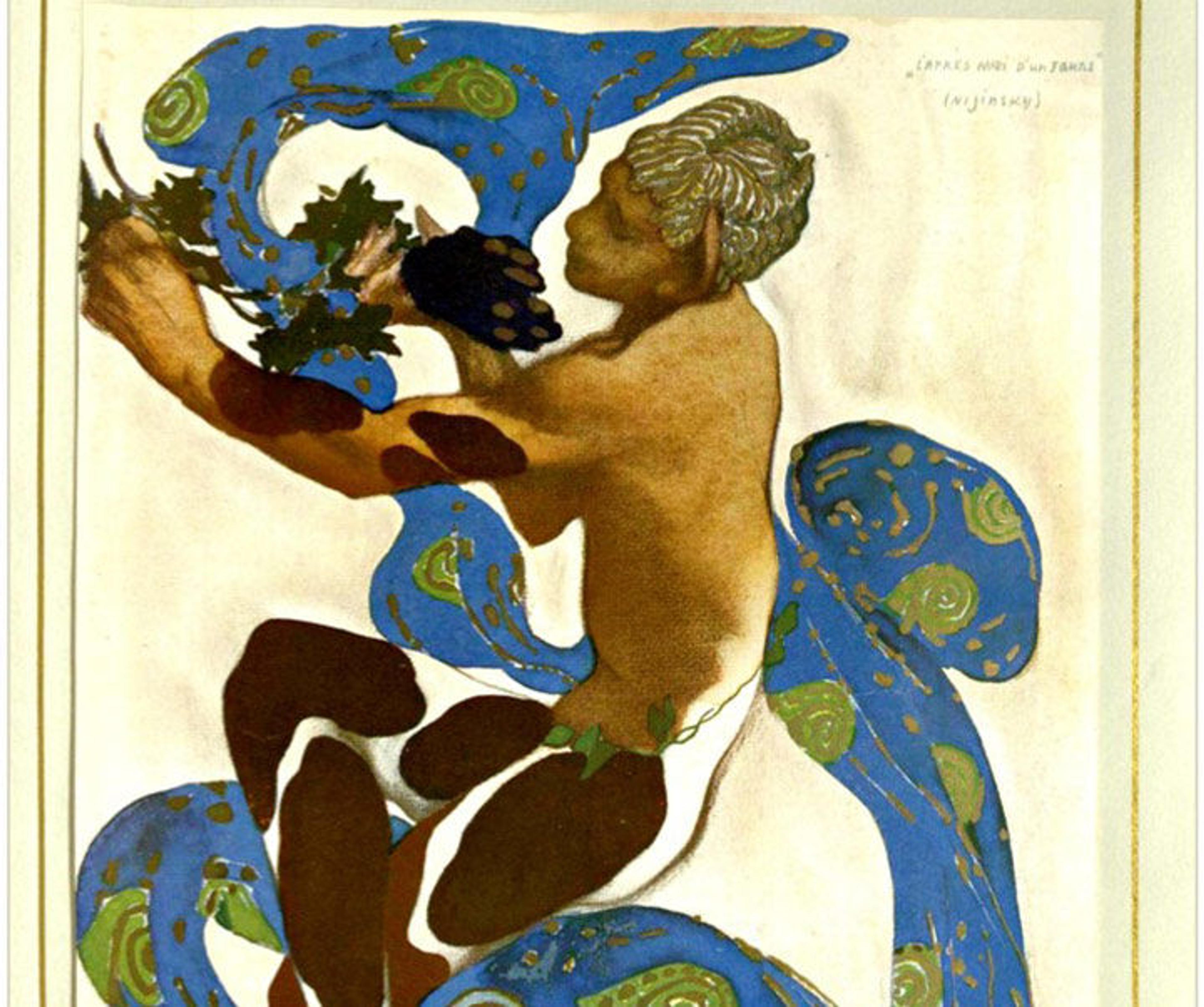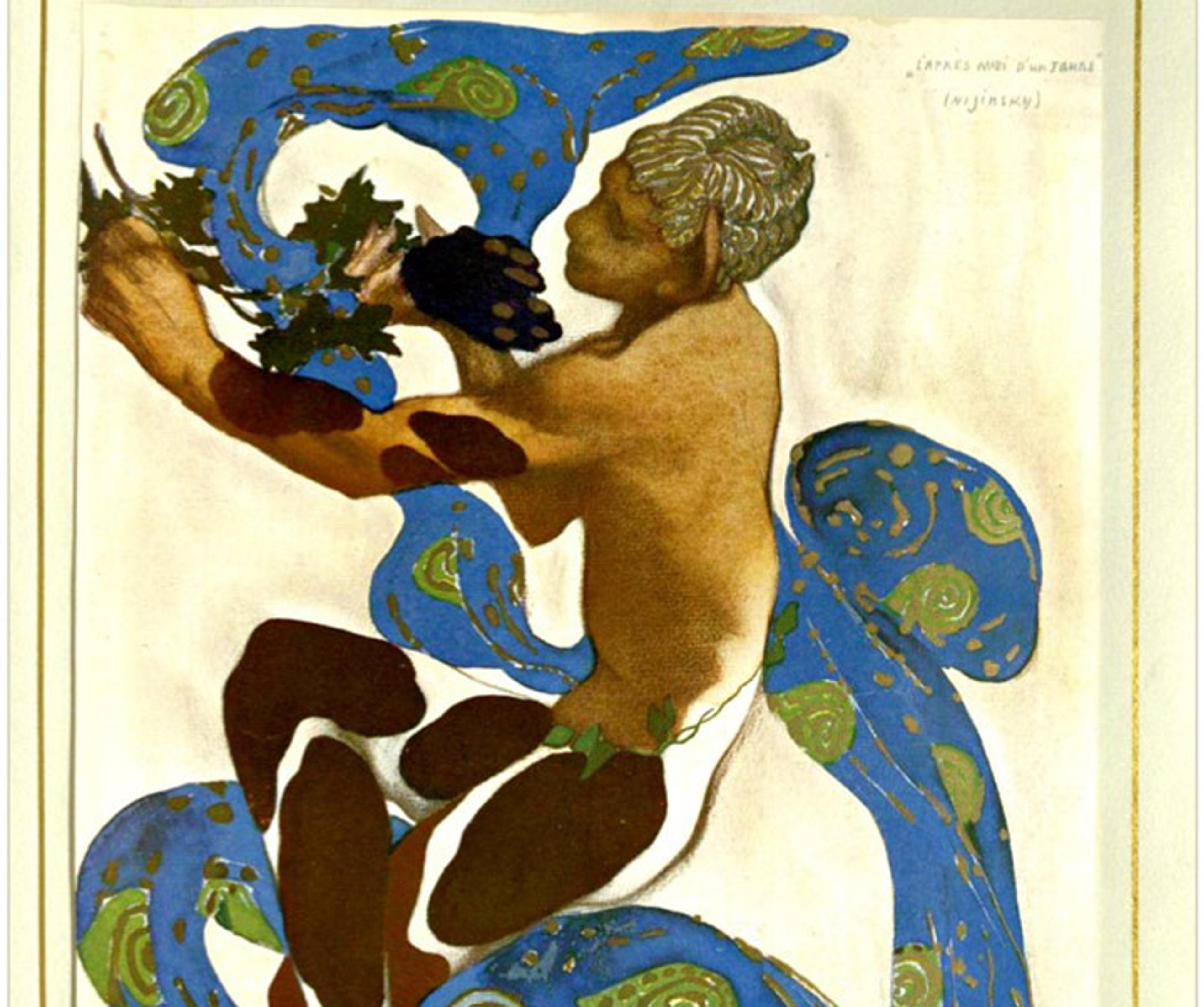
Watercolor reproduction of Vaslav Nijinsky in Afternoon of the Faun (1912). Alexandre, Arsène. The Decorative Art of Léon Bakst. London: Fine Art Society, 1913.
«Are you a dancer, ballet enthusiast, or modern-dance connoisseur? From trailblazing, avant-garde monographs to colorful souvenir programs, Watson's dance holdings are wide-ranging and sure to excite.»
This vibrant rendering of Vaslav Nijinsky in Afternoon of the Faun (above) reflects the energetic dance movements of the Ballets Russes founded by Sergei Diaghilev. With 77 mounted plates showcasing the company's productions, Léon Bakst's costume and set-design illustrations in this lavish review of his work convey the abstracted body angles and exotic costumes of the Ballets Russes. Watson Library has all of the important books on Bakst, including this colorful quarto-sized volume representing the main body of his work.
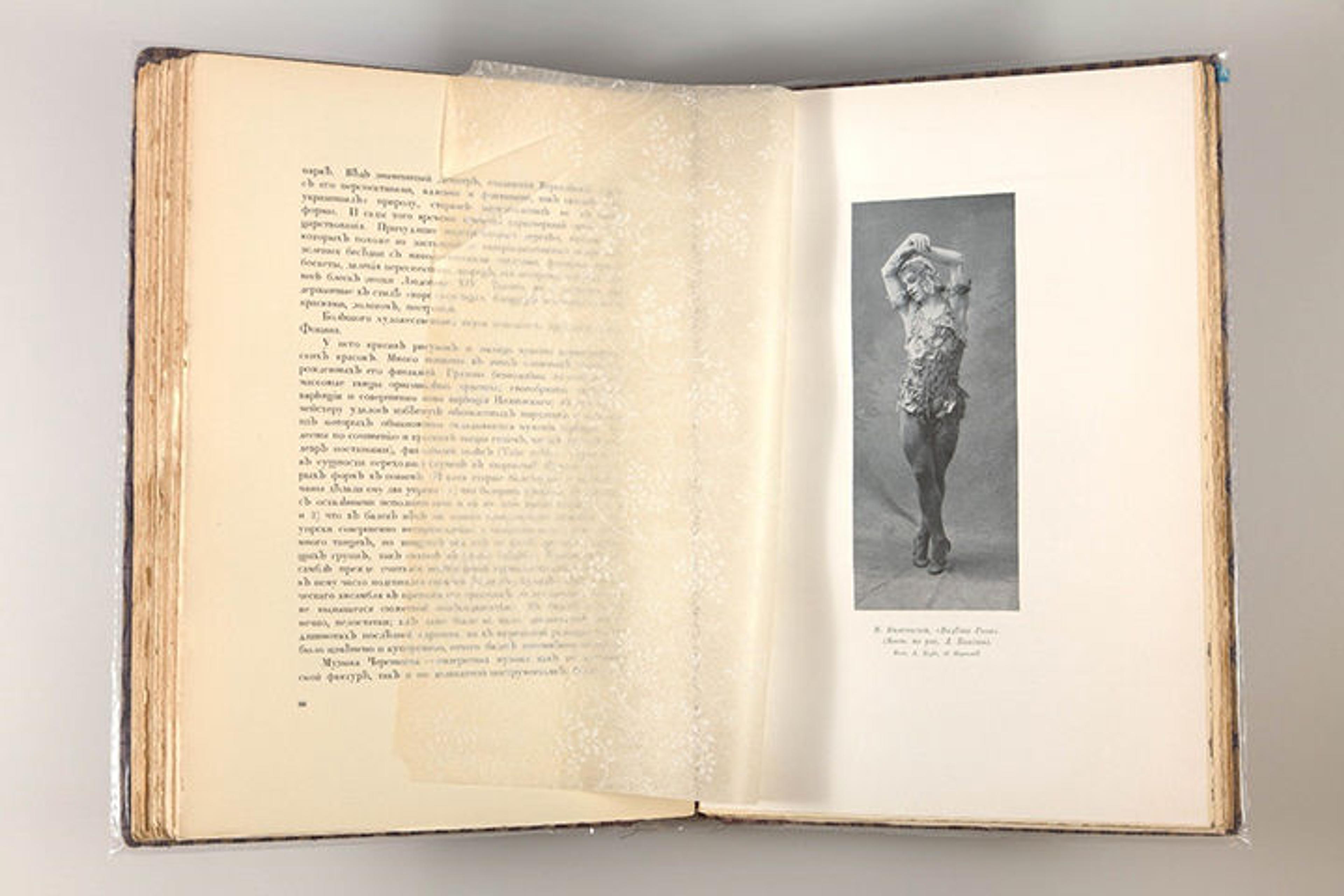
Svietlov, Valerīan. Sovremennyĭ balet. Saint Petesrburg: T-vo R. Golike i A. Vil'borg, 1911.

Sovremennyĭ balet, silk patterned cover and decorative endpapers
The beautifully bound Russian history above, written by dance critic Valerian Svetloff, defends "Sovremennyĭ balet" or "modern ballet," describing the transformation from classical dance to modern through lithographs, photographs, and essays. It has the original binding with lavender silk covers and printed tissue interleaving.
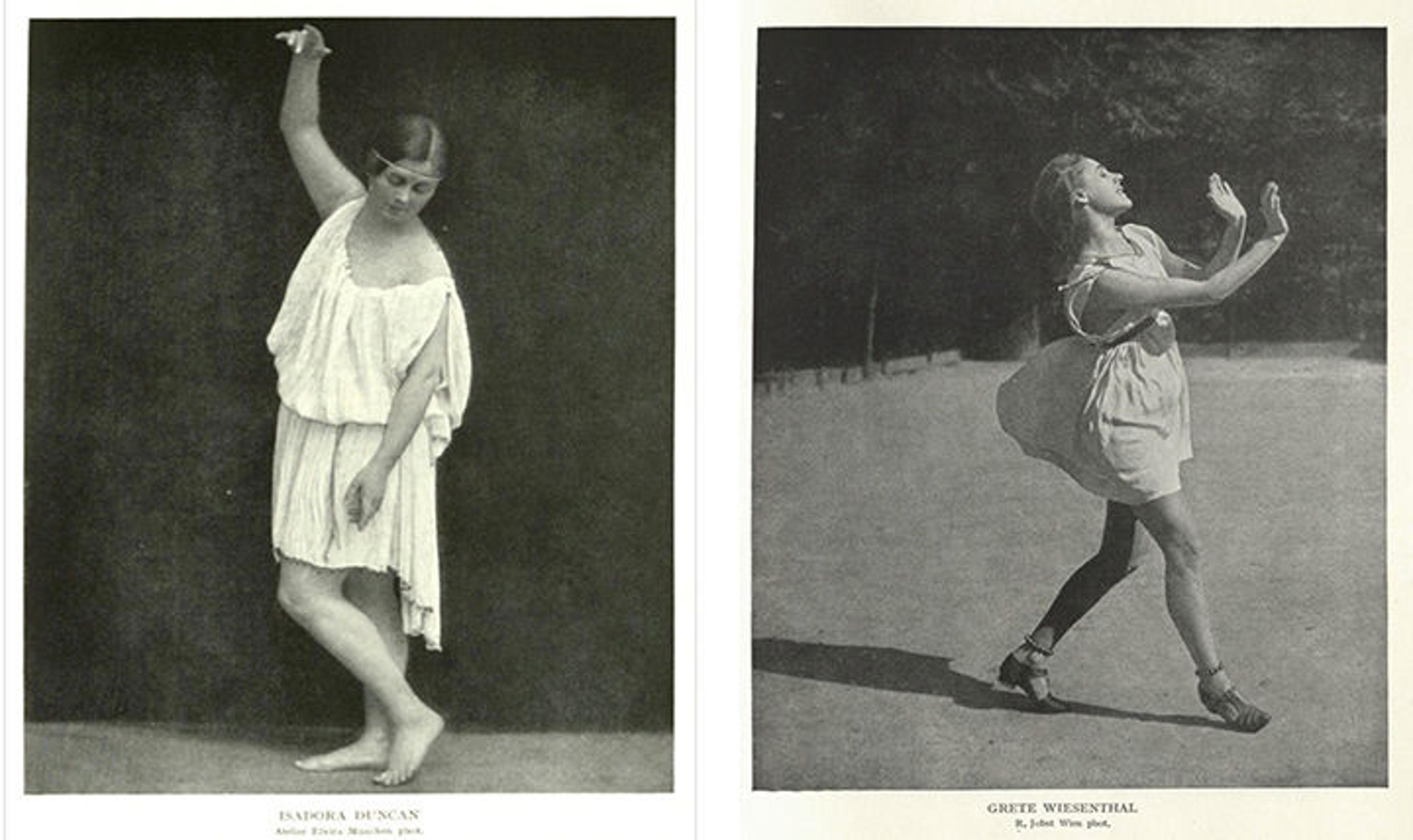
Brandenburg, Hans. Der Moderne Tanz. München: Bei Georg Müller, 1913.
Another book extolling early modern dance is Hans Brandenburg's history, which includes 120 reproductions of drawings and 75 photographs describing dance performances and positions. It is marked by chapters devoted to Isadora Duncan, Russian ballet, and the Wiesenthal Sisters, and evaluates the style, costume, and practice of early 20th-century interpretive dance pioneers.
As modern dance continued to evolve, varying forms and philosophies emerged, and, along with them, lively books introducing theories of international dance movement.
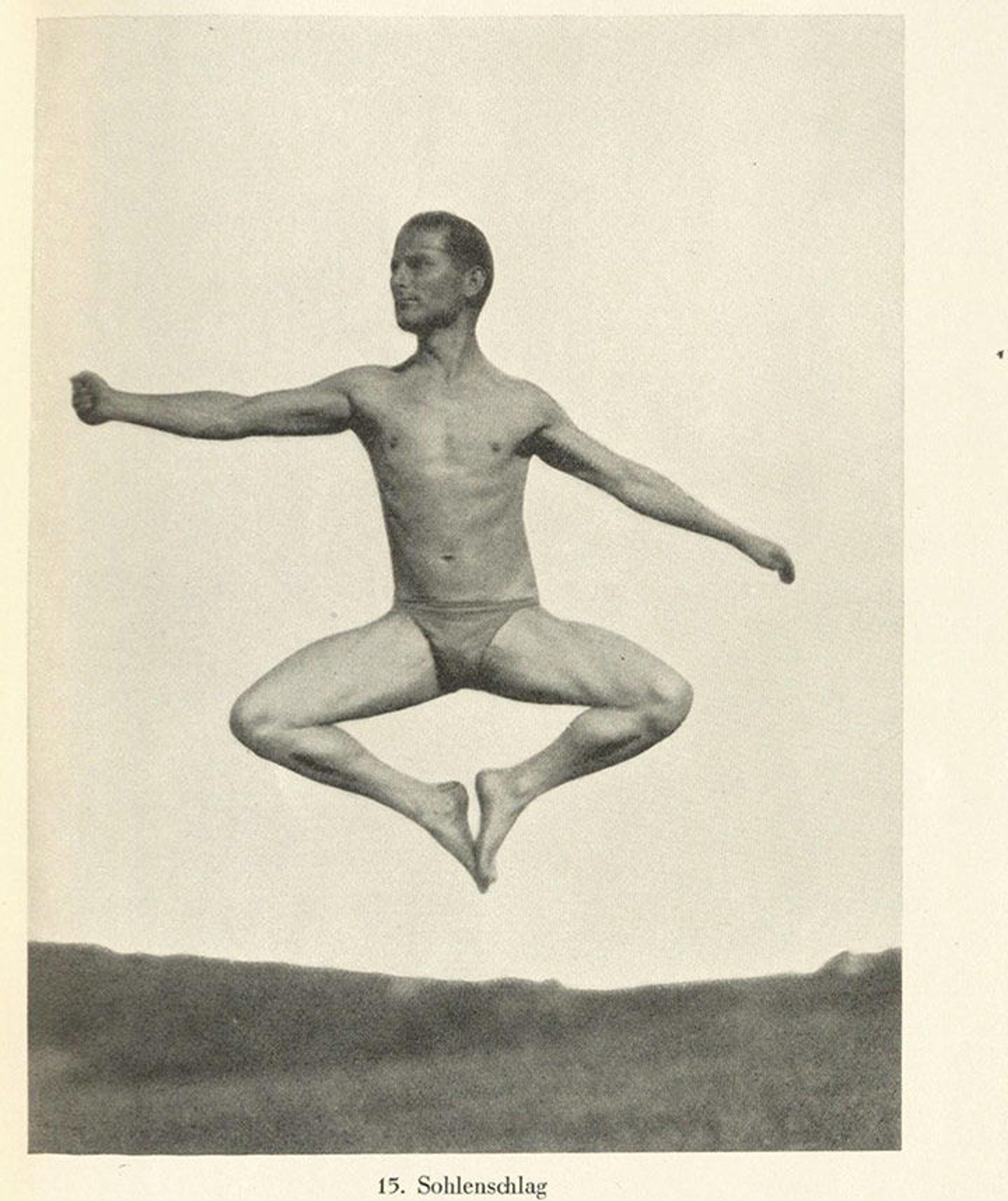
Glucker, August. Der fliegende Mensch: gymnastische Sprungübungen. Oldenburg: Gerhard Stalling Verlag, 1926.
This spry German instructional book, for example, on how to perform gymnastics while airborne, features gravity-defying leaps shown against the backdrop of nature.

Jsenfels, Paul. Getanzte Harmonien. Stuttgart: Dieck, 1927.
Another exuberant book on modern dance, Getanzte Harmonien ("Dance Harmonies"), is marked by energetic illustrations of figures chiefly running, jumping, and leaping in athletic and balletic poses.
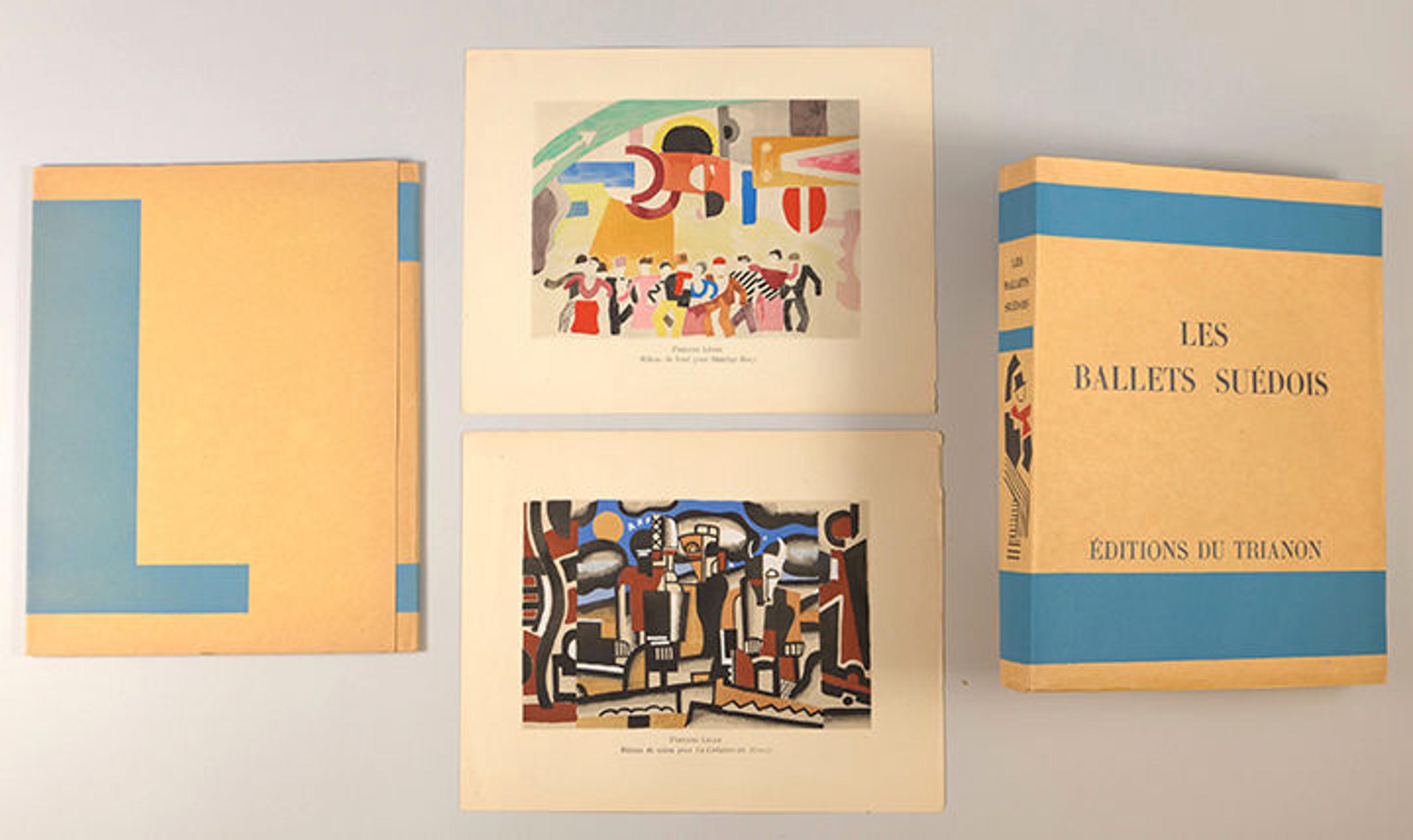
Les Ballets suédois dans l'art contemporain. Paris: Editions du Trianon, 1931.
The synthesis of dance and art, a hallmark of the Ballets Russes, is represented in th limited-edition compendium Les Ballets suédois. Under the direction of Rolf de Maré, this Swedish dance ensemble was located in Paris and performed in Europe and the United States from 1920 to 1925. Fernand Léger designed the covers and enclosure, which includes 14 pochoirs, 64 heliogravures, and contributions by Jean Cocteau and Frances Picabia. The bright pochoirs feature costume designs by Léonard Tsugouharu Foujita and set designs by Léger and Giorgio de Chirico.
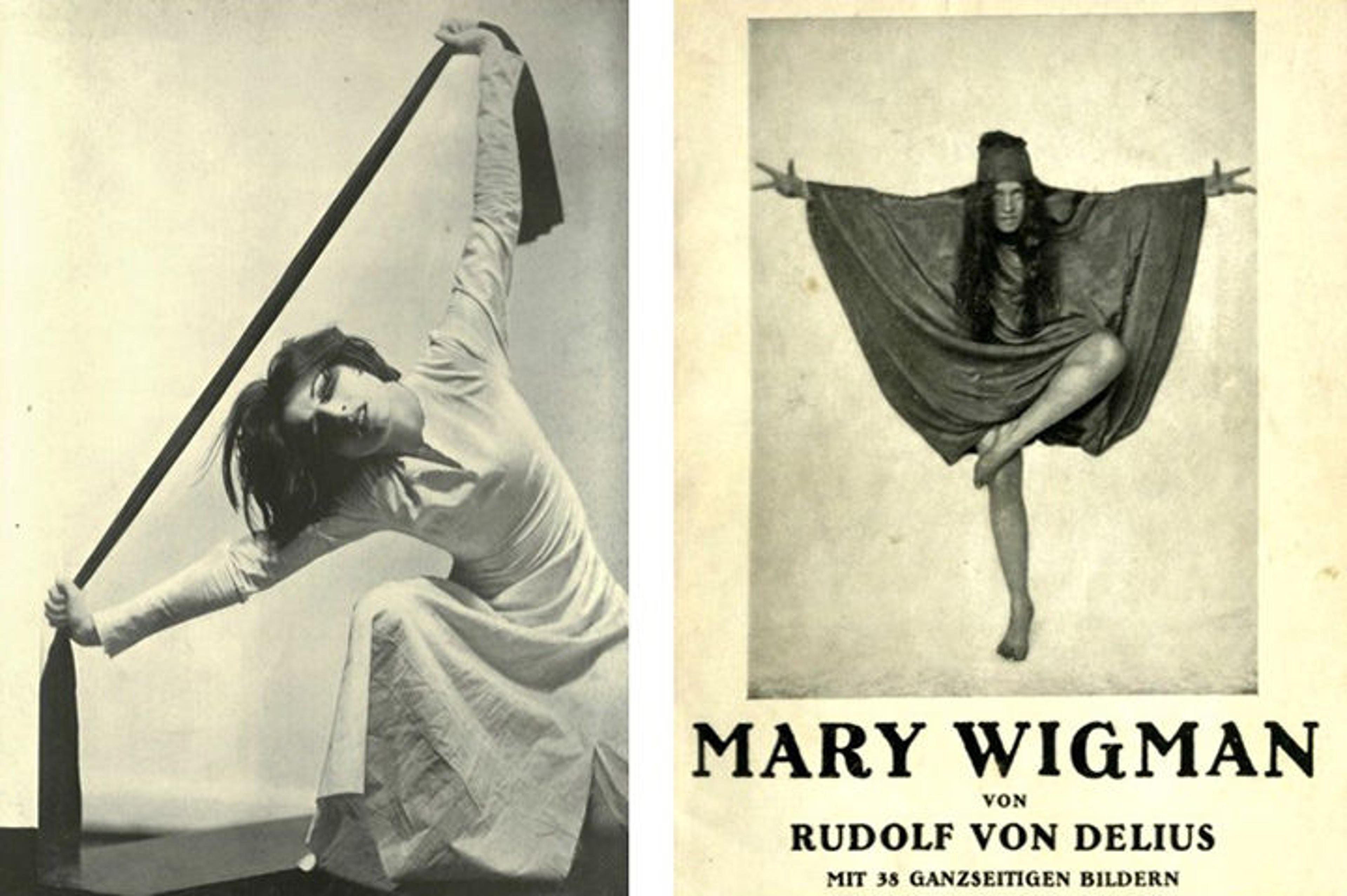
Left: Ruth Page, Kreutzberg, with text and poem by Mark Turbyfill. Chicago, 1934. Right: Delius, Rudolf von. Mary Wigman. Dresden: C. Reissner, 1925.
Two pioneers of modern-dance choreography, Mary Wigman and Ruth Page, are represented in the dramatic monographs above, which capture their emphasis on strong body language. Wigman, one of the originators of expressionist dance and dance therapy, aimed to create poses and moves that echoed the angular shapes of abstract art. Page choreographed hundreds of Americana ballets, worked with some of the greatest artists of the 20th century (including Aaron Copland and Isamu Noguchi), and created the Ruth Page Foundation, which established the Ruth Page Foundation School of Dance, known today as the Ruth Page Center for the Arts.

Left to right: S. Hurok and Harold Holt present Ballets Russes de Monte-Carlo (1939); S. Hurok presents Col. W. de Basil's Ballets Russes de Monte Carlo (1936?); The Ballet Theatre Annual: 1949-1950 (1949)
Following director Sergei Diaghilev's death in 1929 and the subsequent fragmentation of the Ballets Russes, two rival dance troupes emerged as successors: René Blum and Léonide Massine's Ballet Russe de Monte Carlo, and Colonel Wassily de Basil's Original Ballet Russe. Both companies toured the United States extensively from the late 1930s to early 1950s, and these ensembles—along with the Ballet Theatre—contributed to the popularity of dance in postwar America. Both former choreographers of the Ballets Russes, the companies featured the work of Michel Fokine and George Balanchine.
With whimsical covers featuring sets and costumes by leading artists of the time, these programs serve as valuable primary resource material filled with hundreds of dancer names and their photos, program lists, set designs, and local advertising.
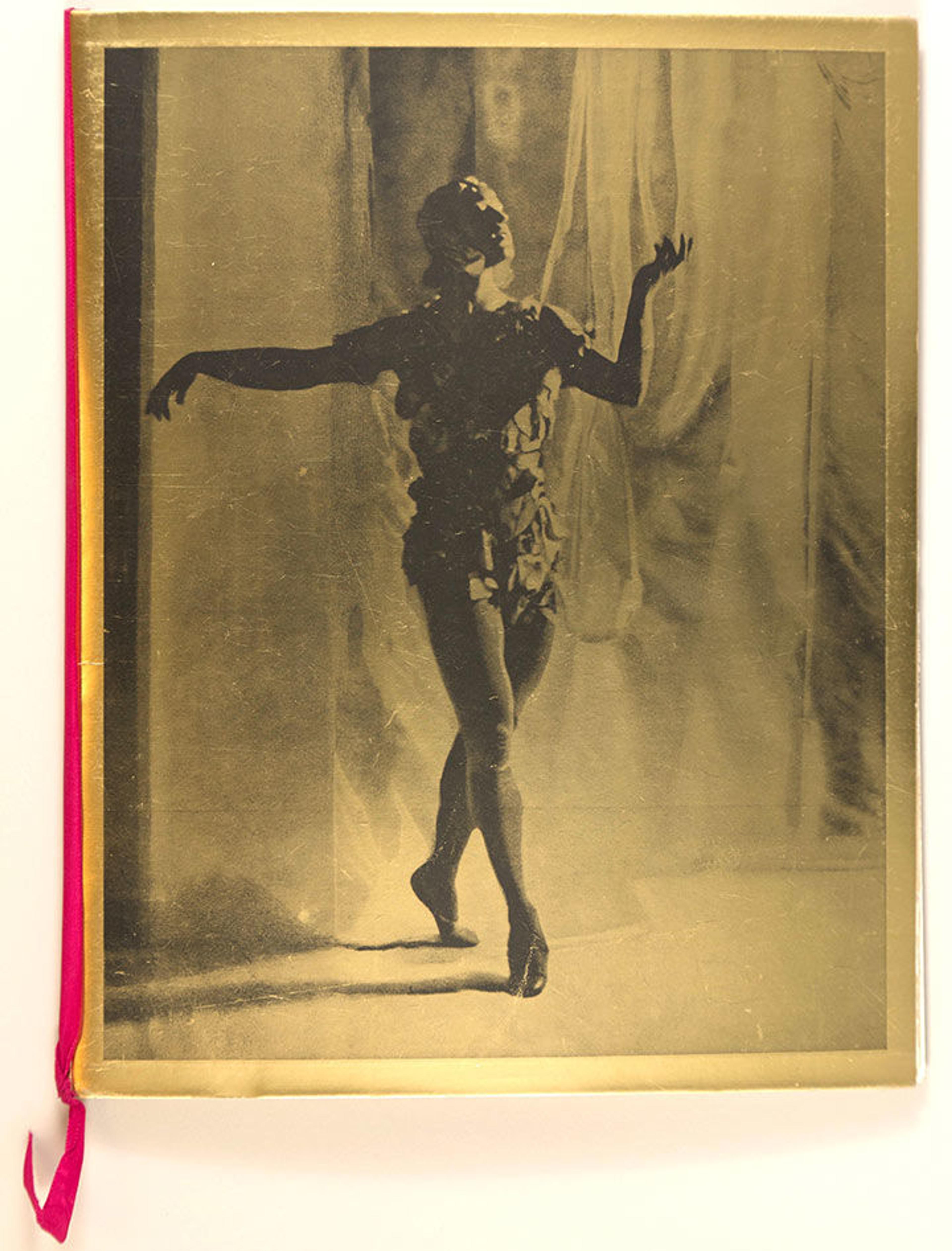
Baron Adolf de Meyer's image of Nijinsky in Le Spectre de la Rose (1911). Cover of Gala de danse au bénéfice de Vaslav Nijinsky: organisé par Serge Lifar sous le patronage du Comité de l'Art des Fêtes de Paris: le 28 juin 1939, dans le cadre de l'Exposition des Ballets Russes de Diaghilew. Paris: Jacques de Brunhoff, 1939.
This elegant souvenir program, with gold anodized wrappers and a silk tie, honors Nijinsky, the greatest male dancer of the early 20th century. Including drawings by Jean Cocteau and the program for the gala event, Watson's copy also has a ticket and flyer. Ukrainian-born choreographer, dancer, writer, and then–ballet master of the Paris Opera, Serge Lifar, organized this program to raise funds for an ailing Nijinsky, who was in a sanatorium at the time. Lifar was considered the successor to Nijinsky in the Ballets Russes when he made his debut in 1923.
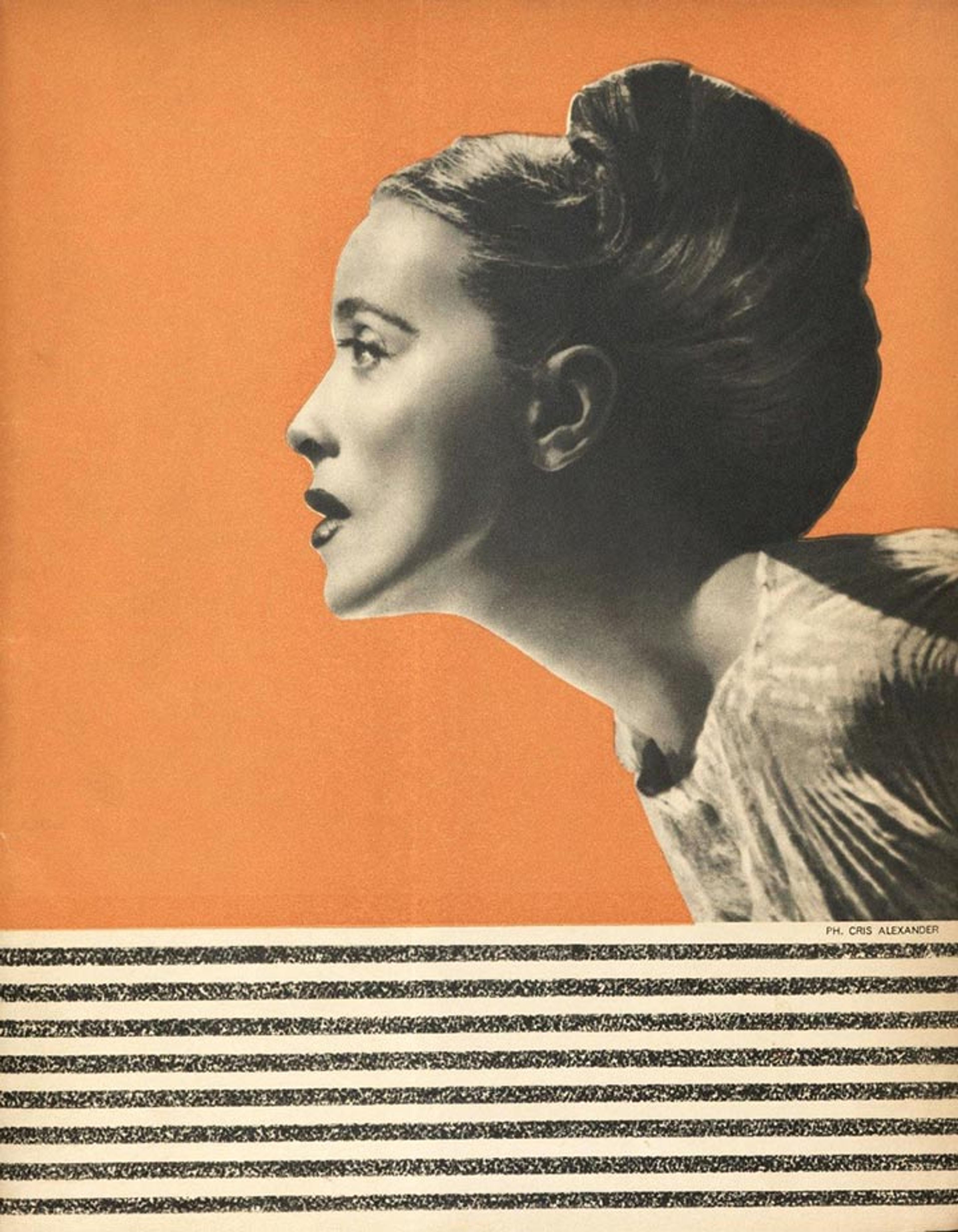
Martha Graham and Dance Company. New York: L.C. Dunetz and P. Lovett, ca. 1949.
A dynamic Martha Graham Dance Company brochure boasts a streamlined cover as modern as her moves. In addition to this title, Watson Library has more than 40 holdings on Graham, including the 1960s "selection of photographs, souvenirs and memorabilia" also published by Dunetz and Lovett, and Merle Armitage's 1937 compendium of Graham, which includes articles by Lincoln Kirstein and John Martin.
Our dance holdings also extend to subjects incorporating the performing arts including Yvonne Rainer's Work 1961-73 (Halifax, 1974) and Tatsumi Hijikata's Dance experience no kai (Tokyo, 2012).
Many of these important publications on ballet and modern dance were purchased with funds provided by the Friends of Thomas J. Watson Library. Stop by Watson Library any time we're open to request these and other inspiring books on dance.
